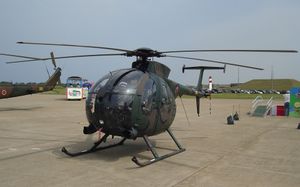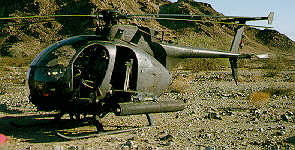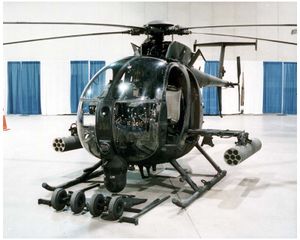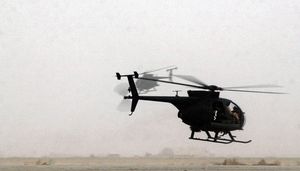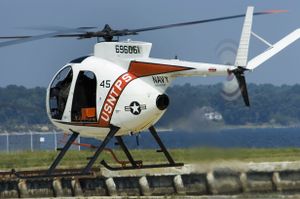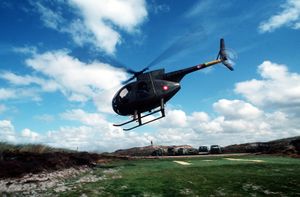PlaneSpottingWorld welcomes all new members! Please gives your ideas at the Terminal.
OH-6 Cayuse
- H-6 redirects here. For the Chinese medium range bomber, see Xian H-6.
| OH-6A Cayuse | |
|---|---|
| Right side view of the OH-6 Cayuse helicopter in flight. | |
| Type | Light observation helicopter |
| Manufacturer | Hughes Tool Co. - Aircraft Division |
| Maiden flight | February 27, 1963 |
| Introduced | 1966 |
| Status | Active service |
| Primary user | United States Army |
| Produced | 1965- |
| Variants | MD 500 |
The Hughes Helicopters OH-6A Cayuse (nicknamed Loach) is a single-engine light helicopter with a four-bladed main rotor used for personnel transport, escort and attack missions, and observation. The MH-6 and AH-6 (nicknamed Little Bird) were originally modified OH-6As used for special operations aviation, they have since been developed into single-engine light helicopters with a single five-bladed main rotor, based on the MD 500E. The newest version, the MH-6M, is based on the MD 530F and has a single, six-bladed main rotor and four-bladed tail rotor. Hughes also developed the Model 369 as a civilian helicopter, the Hughes Model 500, currently produced by MD Helicopters. (See MD Helicopters MD 500)
Contents
Development
In 1960, the United States Army issued Technical Specification 153 for a Light Observation Helicopter (LOH) capable of fulfilling various roles: personnel transport, escort and attack missions, casualty evacuation and observation. Twelve companies took part in the competition and Hughes Tool Company's Aircraft Division submitted the Model 369. Two designs, those submitted by Fairchild-Hiller and Bell, were selected as finalists by the Army-Navy design competition board, but the U.S. Army later included the helicopter from Hughes as well.
The first Model 369 prototype flew on February 27, 1963. Originally designated as the YHO-6A according to the Army's designation system, the aircraft was redesignated as the YOH-6A in 1962 when the Department of Defense created a Joint designation system for all aircraft. Five prototypes were built, fitted with a 252 shp Allison T63-A-5A,[1] and delivered to the U.S. Army at Camp Rucker, Alabama to compete against the other 10 prototype aircraft submitted by Bell and Fairchild-Hiller. During the course of the competition, the Bell submission, the YOH-4, was eliminated[1] as being underpowered (it used the 250shp T63-A-5). The bidding for the LOH contract came down to Fairchild-Hiller and Hughes. Hughes won the bid[2] and the Army awarded a contract for production in May 1965, with an initial order for 714 which was later increased to 1300 with an option on another 114. Production reached 70 helicopters in the first month.
Japanese OH-6
In Japan, 387 OH-6s were produced under licence by Kawasaki Heavy Industries and used by the Japanese Ground Self-Defense Force (JGSDF), Japanese Maritime Self-Defense Force (JMSDF), the Japanese Coast Guard, and civilian operators. Beginning in 2001, the OH-6s of the JGSDF are in the process of being replaced by Kawasaki's new observation helicopter, the Kawasaki OH-1.
History
Shortly after production began, the OH-6 began to demonstrate what kind of an impact it would have on the world of helicopters. The OH-6 set 23 world records for helicopters in 1966 for speed, endurance and time to climb. On March 23, 1966, Jack Schwiebold set the closed circuit distance record in a YOH-6A at Edwards Air Force Base, California. He flew without landing for 1,739.96 mi (2,800.20 km). And on April 7, 1966, Robert Ferry set the long distance world record for helicopters. He flew from Culver City, California to Ormond Beach, Florida, covering a total of 1,923.08 nm (2,213.04 mi, 3,561.55 km).
Production OH-6A craft entered service in 1966, arriving in the Vietnam War theater. The pilots dubbed the little helicopter Loach, a word created by pronunciation of the acronym of the program that spawned the aircraft, LOH. The helicopter quickly became noted for high performance and low noise due its four-bladed rotor and small size. The OH-6A would act as a scout to spot enemy positions, while only lightly armed with a fixed minigun. The most common configuration had an observer/gunner either in the left seat or in the rear seat. Most commonly, the Loach worked in conjunction with another OH-6A or an AH-1G. A team of OH-6A aircraft was sometimes known as a "White team", and a team comprised of an OH-6A and an AH-1G was known as a "Pink team".
160th Special Operations Aviation Regiment
Following the April 1980 failure of Operation Eagle Claw, it was determined that the military lacked aircraft and crews who were trained and prepared to perform special operations missions. To remedy this shortcoming, the Army began developing a special aviation task force to prepare for the next attempt to rescue the hostages.
Task Force 160th
The architects of the task force identified the need for a small helicopter to land in the most restrictive locations and that was also easily transported on Air Force transport aircraft. They chose the OH-6A scout helicopter to fill that role, and it became known as the Little Bird compared to the other aircraft in the task force, the UH-60A and the CH-47C. As a separate part of the project, armed OH-6As were being developed at Fort Rucker, Alabama. The pilots selected to fly the OH-6A helicopters came from the 229th Attack Helicopter Battalion and were sent to the Mississippi Army National Guard's Army Aviation Support Facility (AASF) at Gulfport, Mississippi, for two weeks of qualification training in the aircraft. When the training was completed, C-141 aircraft transported the aircraft and crews to Fort Huachuca, Arizona, for two weeks of mission training. The mission training consisted of loading onto C-130 transport aircraft which would then transport them to forward staging areas over routes as long as 1000 nautical miles. The armed OH-6 aircraft from Fort Rucker joined the training program in the fall of 1980.
Operation Honey Badger was cancelled after the hostages were released on 20 January 1981, and for a short while, it looked as if the task force would be disbanded and the personnel returned to their former units. But the Army decided that it would be more prudent to keep the unit in order to be prepared for future contingencies. The task force, which had been designated as Task Force 158, was soon formed into the 160th Aviation Battalion. The OH-6A helicopters used for transporting personnel became the MH-6 aircraft of the Light Assault Company and the armed OH-6As became the AH-6 aircraft of the Light Attack Company. [3]
Operation Prime Chance
On 24 July 1987, a Kuwaiti oil tanker, reflagged as the Bridgeton, struck a mine in the Persian Gulf even though it was escorted by U.S. Navy ships. It became apparent that more than the mere presence of escort ships would be required to safeguard merchant traffic, so, MH-6 and AH-6 aircraft from the 160th Aviation Battalion were called upon to provide surveillance and patrols in cooperation with other U.S. special operations units. Two MH-6 and four AH-6 aircraft were initially deployed and designated as Detachment 160 Aviation Group (DET 160 AVGP). The MH-6 aircraft were equipped with Forward Looking Infra-Red (FLIR) and a videotape system which gave them excellent ability to detect, identify and then vector the armed AH-6 to the targets. The AH-6 helicopters were armed with 7.62 miniguns and 2.75-inch rockets. Initially, the aircraft patrolled in teams (call sign "SEABAT") waiting for U.S. Navy SH-2s to identify and direct the Little Birds to the targets but it was determined that to preserve the aircraft and crews from unnecessary fatigue and wear that the teams would remain on the ship's deck until a contact was identified.
At 2200 hours on 21 September 1987, the SEABAT team (an MH-6 and two AH-6s) from the USS Jarrett was launched by the ship's captain in response to possible mining activity. The team successfully located the Iran AJR, a cargo ship modified for mining operations. After the MH-6 confirmed the activity of the ship, the AH-6s engaged the ship causing the crew to abandon the ship and it was subsequently boarded and captured.
On the evening of 8 October 1987, a Revolutionary Guard Corps Boghammar and two Boston whaler boats were detected by an SH-2. The SEABAT team was launched and as the MH-6 drew near to investigate it was fired on by the Boghammar. In a series of engagements by both AH-6s and the MH-6 (recently armed with a minigun) during which the Boghammar also returned fire, including launching two STINGER missiles at the helicopters, all three boats were sunk.
For the remainder of the operation it was decided that barges set up as mobile sea bases (MSB) would facilitate the operation of the special operations forces. The Hercules and the Wimbrown VII were leased to provide these bases and the SEABAT teams began operating from the barges.
In early 1988, it was decided that modified Army OH-58D (AHIP) helicopters, fitted with weapons systems, would replace the SEABAT teams. On 24 February 1988, a team of two AHIP helicopters replaced the SEABAT team on the Wimbrown VII but it would be several months (June 1988) before the SEABAT team aboard the barge Hercules would be relieved by another AHIP detachment. [4]
Operation Just Cause
On 17 December 1989, 9 MH-6s, 11 AH-6G/Js, 19 UH/MH-60As were transported by Air Force C-5 Galaxy transports in preparation for Operation JUST CAUSE, arriving at Howard AFB on Monday, 18 December. The aircraft and the personnel were offloaded and moved to Hangar 3 where they remained throughout the sweltering heat of the next day. After dark, on Tuesday, 19 December, the aircraft were rolled out of the hangar in preparation for missions in support of Operation JUST CAUSE.
The missions for the Little Birds included the pre-H-hour insertion of a beacon and combat controllers by two MH-6s supported by two AH-6s at Torrijos-Tocumen Airport. Another mission involved four AH-6s conducting pre-assault attacks on the Panamanian Defense Force (PDF) Headquarters, La Comandancia, adjoining the heavily populated El Chorrillo neighborhood in downtown Panama City. One of the AH-6s was shot down and crash landed in the Comandancia compound. The two pilots survived but were pinned down by small arms fire for two hours. They were able to evade back to friendly forces, taking a PDF soldier prisoner along the way.
A key mission during JUST CAUSE was a rescue operation, called Operation Acid Gambit, conducted at Cárcel Modelo, a prison adjacent to La Comandancia. AH-6s escorted MH-6s to perform a rooftop assault on the prison. As the aircraft approached the prison, they received fire from a nearby apartment house. Despite the heavy fire, the Little Birds were able to land on the roof, drop off the rescue team, and lift off. When they returned to pick up the team, there was heavy smoke throughout the area, making it difficult to locate the rooftop of the prison. Meanwhile, the aircraft continued receiving heavy fire from a cellblock about 50 to 60 feet from the landing site. MAJ Richard Bowman was serving as a copilot at the controls of one of the Little Birds when he took a round in the elbow. His pilot took over the controls and successfully landed the aircraft. The team of aircraft picked up the rescue personnel and departed to fly directly back to Howard AFB. However, one MH-6 in the flight lost power as it departed the roof of the prison. It crashed in the street below with minor injuries to the passengers. Infantry soldiers securing the perimeter assisted the aircrew and passengers in moving from the crash site.
Elsewhere, four AH-6s provided direct fire support for the airborne assault at Rio Hato Airfield. They were supported by an MH-60 which operated as a Forward Arming and Refuel Point (FARP). Two nine-man teams from the 160th participated in the airborne assaults of Torrijos-Tocumen Airfield and Rio Hato Airfield, and were dropped from Air Force C-141s to set up FARPs. The FARPs consisted of 12-foot platforms with HE-rocket and minigun ammunition, parts and replacements for the miniguns, and fuel and refueling pumps, hoses, etc. The FARP dropped at Rio Hato landed in a marsh and was not able to be used. As a result, for the rest of the operation, the team had to “wet wing” refuel directly from the MH-60 on the ground.
The Rio Hato mission originally included nine other MH-60s and four MH-6s. Several hours prior to H-hour, these aircraft and crews were instead sent to support a raid in the vicinity of Colon, a key PDF stronghold where PDF leaders were believed to be. At H-hour, the nine MH-60s and four MH-6s conducted an air assault raid on a beach house along the coast of Colon. It was during this mission the 160th received its only fatalities when an AH-6, also supporting the operation, was shot down. Another force of eight MH-60s and four MH-6s were on strip alert to conduct follow-on raids should the need arise during the H-hour operations.
After these initial missions, elements of the 160th continued to provide support as special operations forces attempted to secure outlying areas, recover weapons caches, and “hunt for Elvis”, the phrase the men of the 160th used to refer to the search for General Noriega. A small force of four MH-60s, two MH-6s, two AH-6s, and two MH-47s was moved to Ft. Sherman in the north to stage for operations in and around Colon.
The 160th conducted numerous air assault missions over the next two weeks, and on 3 January 1990, the majority of the force redeployed back to Fort Campbell, Kentucky.[5]
Operation Gothic Serpent
MH-6 Little Birds were part of the initial assault on the Olympic Hotel in the Bakarah Market of Mogadishu, Somalia. The MH-6s conducted rooftop insertions of Delta Force soldiers.
After the shootdown of the MH-60A, callsign "Super 61", by an RPG, an MH-6 Little Bird, call sign "Star 41", piloted by CW4 Keith Jones and CW3 Karl Maier, landed in the street next to the downed MH-60 and attempted to evacuate the casualties. Jones went to assist survivors, successfully pulling two soldiers into the Little Bird, while Maier laid down suppressive fire from the cockpit with his individual weapon. Under intense ground fire, the MH-6 departed with its crew and survivors.[6]
During the night, AH-6 gunships provided fire support to Rangers and Delta Forces who were in defensive positions around the crash site of "Super 61" and under constant fire from Warlord Mohammad Farrah Aidid's militia members.[7]
Variants
- OH-6A
- Production observation helicopter for the US Army.
- OH-6J
- Light observation helicopter for the Japanese Ground Self Defence Force, produced under licence by Kawasaki Heavy Industries and based on the OH-6A Cayuse light observation helicopter.
- OH-6D
- Light observation and scout helicopter for Japanese Ground Self Defence Force, also built under licence by Kawasaki Heavy Industries but based on the civilian Hughes Model 500D helicopter.
- TH-6B
- A Navy derivative of the MD-369H, six McDonnell Douglas TH-6B Conversion-in-Lieu-of-Procurement aircraft are used as an integral part of the United States Naval Test Pilot School's test pilot training syllabus. The aircraft and associated instrumentation and avionics are used for the in-flight instruction and demonstration of flying qualities, performance and missions systems flight test techniques.[8]
- AH-6C
- EH-6E
- MH-6E
- Improved attack helicopter used by US Army special forces units, and stealthy light attack and transport helicopter for US Army special forces units.
- AH-6F
- AH-6G
- MH-6H
- AH/MH-6J
- Improved special forces transport and attack versions. Updated light attack helicopter based on the MD 530MG and equipped with an improved engine, FLIR, and a GPS/inertial navigation system.
- AH/MH-6M
- Also occasionally referred to as the Mission Enhanced Little Bird (MELB), it is a highly modified version of the MD 530 series commercial helicopter.[9]
- A/MH-6X / MH/AH-6X Unmanned Little Bird (ULB)
- An unmanned autonomous version of the Little Bird.[citation needed] There is also an Unmanned autonomous version of the MELB, the UMELB.[citation needed] These test craft have over 500 hundred total hours of autonomous flight and are used to expand knowledge about unmanned rotorcraft as well as used as a test platform for other rotorcraft technologies.[citation needed] These test craft can be flown in a full autonomous mode, or piloted, allowing them to rapidly transition from manned to unmanned modes of use.[citation needed]
Military Operators
- Argentina, Bahrain, Bolivia, Brazil, Chile, Colombia, Costa Rica, Denmark, Dominican Republic, Ecuador, El Salvador, Finland, Greece, Haiti, Honduras, Indonesia, Iraq, Israel, Italy, Japan, Jordan, Kenya, Mauritania, Morocco, Nicaragua, North Korea, Philippines, South Korea, Spain, Taiwan, United States Army,United States Navy
Specifications
General characteristics
- Crew: 2
- Length: 30 ft 10 in - 32 ft 2 in (9.4 m - 9.8 m)
- Rotor diameter: 27 ft. 4 in (8.33 m)
- Height: 8 ft 6 in - 11 ft 2 in (2.6 m - 3.4 m)
- Empty weight: 1,975 lbs (896 kg)
- Max takeoff weight: 3,549 lbs (1,610 kg)
- Powerplant: 1× One Allison T63-A-5A or T63-A-700 Turboshaft, 317 hp (236 kW)
Performance
- Maximum speed: 152 knots (175 mph, 282 km/h)
- Cruise speed: 135 knots (155 mph, 250 km/h)
- Range: 232 nm (430 km (267 mi))
- Service ceiling: 15,994 ft (4,875 m)
- Rate of climb: 2,067 ft/min (10.5 m/s)
Armament
- Guns: Two M60 or M134 Minigun 7.62 mm machine gun; Two .50 cal (12.7 mm) MG pods
- Rockets: Two 2.75 in (70 mm) Hydra 70 rocket pods
- Missiles: Two TOW missile pods; Two Hellfire
References
Related content
Related development
Comparable aircraft
Designation sequence
- Hughes/MD:
- U.S. Army (pre 1962):
- US Joint Service (post 1962):
Related lists
See also
- Boeing Integrated Defense Systems, the present owners of McDonnell Douglas
Lists relating to aviation | |
|---|---|
| General | Timeline of aviation · Aircraft · Aircraft manufacturers · Aircraft engines · Aircraft engine manufacturers · Airports · Airlines |
| Military | Air forces · Aircraft weapons · Missiles · Unmanned aerial vehicles (UAVs) · Experimental aircraft |
| Notable incidents and accidents | Military aviation · Airliners · General aviation · Famous aviation-related deaths |
| Records | Flight airspeed record · Flight distance record · Flight altitude record · Flight endurance record · Most produced aircraft |
da:H-500M de:Hughes MH-6 ja:OH-6 (航空機) fi:MD500 sv:Hughes H-6
